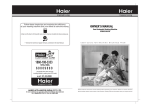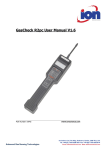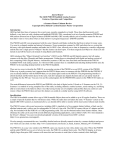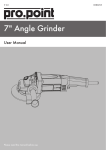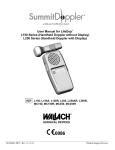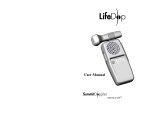Download Monitor GF 500 Specifications
Transcript
SAFETY ALERT SYMBOL These symbols appear as important safety precautions and should be understood and followed by the owner to assure safe operation of the heater. For Quick Reference SECTION A: Important Caution SECTION B: Specifications Special Features Safety Features SECTION C: Tools Needed for Heater Installation Accessories You May Need Flue Pipe Extensions SECTION D: Notice Before Installation Heater Installation Flue Pipe Clearances SECTION E: Gas Connection SECTION F: Operating Instructions Starting Instructions Adjusting Room Temperature Turning Off the Heater Relighting the Heater Programming the Heater Programming for Automatic Heater Operation Manual Operation SECTION G: Protective Features • Loss of Power-Automatic Reset Electrical Fuse Overheat Prevention SECTION H: Maintenance and Check SECTION I: Trouble Shooting Guide SECTION J : Wiring Diagram Block Diagram SECTION K: Parts List COPYRIGHT © MONITOR PRODUCTS, INC., Page 1 5 5 5 6 7 8 9 10 11 15 16 17 17 18 18 18 19 19 20 20 20 20 21 22 23 23 24 SECTION A IMPORTANT CAUTION AWARNING IMPROPER INSTALLATION, ADJUSTMENT, ALTERATION, SERVICE OR MAINTENANCE CAN CAUSE PROPERTY DAMAGE, PERSONAL INJURY OR LOSS OF LIFE, REFER TO THE OWNER'S INFORMATION MANUAL PROVIDED WITH THIS APPLIANCE. INSTALLATION AND SERVICE MUST BE PERFORMED BY A QUALIFIED INSTALLER, SERVICE AGENCY OR THE GAS SUPPLIER. ACAUTION • Make sure that flue pipe (exhaust pipe, air supply hose) is connected properly. • Keep heater clean and do not store any flammable items on or near the heater. Don't use the heater for drying clothes. Should anything abnormal occur in the heater, remain calm, turn it off (do not unplug) and contact your Monitor dealer. • Risk of burns. Flue pipe and louver may have high surface temperature. Do not place yourself or others too close to the heater. • Installation of heater in extreme humidity or dust areas is not recommended. Any removal of unit parts or remodeling is strictly forbidden. Do not sit on the heater. Placing ornaments or plants on the heater is not recommended. Excess heat may cause damage to ornament or plant and overwatering or spilling of water may cause shock to you or damage to the heater. Don't spray aerosols on the heater when in operation. Ei.v w<t sf / / Don't allow children to insert articles in the louvers. Keep flammable materials, trees, shrubs etc. away from flue pipe. Do not vent unit into other rooms. Flue pipe must be outside. Do not install nor exhaust the flue pipe into a crawl space or underneath floor nor into a flue or chimney. X Flue or Chimney In areas of heavy snow accumulation, flue pipe may need to be installed higher to avoid being buried. In open areas with strong wind, a wind break may be necessary to avoid exhaust gases being blown back into the intake and causing poor combustion. 24"min (61cm) Long — Extension' kit Must be higher. Snow Exhaust pipe must be kept clear of flammable materials. This heater is not designed to be built in. \ 1 SECTION B SPECIFICATIONS Model No. Type of Appliance Input Rating Output Rating Efficiency Electrical Rating Power Consumption Heated Air Delivery Flue Pipe Hole Dimensions Weight Inlet Gas Supply Pressure Manifold Test Pressure GF500 Fan type direct vent wall furnace Nat. Gas 38,000 BTU/hour LP. Gas 34,500 BTU/hour Nat. Gas 30,700 BTU/hour LP. Gas 27,900 BTU/hour 83% 120V, 60Hz, Less than 2 amperes 80 Watts High 388 Cubic feet/minute Low 300 Cubic feet/minute 2.5 inches diameter Height: 26.6 inches (67.56cm) Width: 28.7 inches (72.90cm) Depth: 13.8 inches (35.05cm) 82 pounds Nat. Gas Max. 10.5 inch W.C. (267 mmH2O) Min. 5.1 inch W.C. (130mmH2O) LP. Gas Max. 13.0 inch W.C. (330 mmH2O) Min. 11.0 inch W.C. (279 mmH2O) Nat. Gas 3.4 inch W.C. (85 mmH2O) LP. Gas 3.4 inch W.C. (86 mmH2O) The minimum and maximum inlet gas supply pressure are for the purpose of input adjustment. The efficiency rating of this appliance is a product of thermal efficiency rating determined under continuous operating conditions and was determined independently of any installed system. SPECIAL FEATURES SAFETY FEATURES AUTOMATIC IGNITION MEMORY BACK UP: Set memory can be kept in case of power failure for up to 5 minutes. DUAL BLOWERS: Separate fans for combustion and room air circulation. THERMOSTATICALLY CONTROLLED: Adjusts to the desired room temperature. BUILT-IN TIMER: Heater will automatically operate as programmed by the user. AUTOMATIC RESET AFTER POWER FAILURE: Heater will automatically resume operation after power is restored. INDICATOR LIGHTS: Easy-to-see signals show when heater is in operation, when timer is activated, and when the burner is operating in low or high modes. SAFE RE-LIGHTING: Heater will not restart until its combustion chamber has cooled. ELECTRICAL PROTECTION: Heater automatically shuts off in the unlikely event of a malfunction in the electrical circuitry or disruption of the power supply. NO EXHAUST IN ROOM: Products of combustion are discharged outdoors. FLUE PIPE: Outside air is drawn through a pipe-withina-pipe venting system. This process preheats combustion air and regains heat from exhaust gases. CLEAN OPERATION: Products of combustion are vented outside. CONSUMES NO ROOM AIR: Air for combustion is drawn from outside. EASY INSTALLATION: Includes all parts required for standard installation. A CAUTION: ALTERNATE POWER SOURCES The Monitor GF500 may not operate when powered by sources such as an auxiliary generator, UPS (Uninterrupted Power Source), inverters, etc. Check with your dealer for guidance on specific applications. SECTION C Before installing your heater, be sure to check and comply with local and state building and electrical codes that may apply to vented heaters in your area. Permanent wiring must be installed by a licensed electrician. TOOLS NEEDED FOR HEATER INSTALLATION Check the following charts to be sure you have all the tools required to install your Monitor GF500 Heating System. STANDARD TOOLS Phillips Head Screwdriver Steel Tape Measure Pen or Pencil Exterior Caulk Yardstick or Long Straight Edge Soapy Water APPLICATION Installation of Heater Parts Taking Measurements Marking Drilling Location Caulking Between Packing and Wall Checking Angle of Hole for Flue Pipe Lubricating Sleeve Hardware SPECIAL TOOLS Electric Drill 2 1/2 inch Hole Saw Attachment Long 1/4 inch Drill Bit Level APPLICATION Accommodating Hole Saw and Drill Bit Cutting Hole for Flue Pipe Drilling Pilot Hole Through Wall Checking Angle of Hole for Flue Pipe and for checking heater level. Fig.1 ACCESSORIES YOU MAY NEED Check the list below and see your MPI dealer for accessories you may need or want for installation of your heating system. ACCESSORY Medium Flue Pipe Long Flue Pipe P/N 8206 P/N 8005 Extra Short, Short, Medium or Long Extension Kit or Elbow Adapter kit (See Flue Pipe Extensions, page 8) APPLICATION For use where wall thickness is up to 14Va inches (36.83cm) For use where wall thickness is up to 20'/2 inches (52.07cm) For use where "standard" installation is not practical FLUE PIPE EXTENSIONS Four standard extension kits are available from your Monitor dealer. Most installations can be made with one of these kits. In special cases, custom installations may be required. These may be made with components purchased from your dealer. In any installation the following limitations MUST NOT BE EXCEEDED: 2. These elbows should include the one used at the heater but not the one on the air supply hose nor the integral bends in the flue pipe. (See Figure 2) 3. The correct damper as shown on Page 13 must be used. 4. Follow carefully the instruction included with each kit. 1. The total length of the intake or exhaust pipe should not exceed 10 feet (3.05m) with 3 elbows, 13 feet (3.96m) with 2 elbows, or 161/2 feet (5.3m) with 1 elbow. Exhaust Elbow Air Supply Hose 90° Joint Flue Pipe * Do not count Fig. 2 SECTION D NOTICE BEFORE INSTALLATION The heater must be installed by a qualified service person according to this installation instruction . The installation must conform with local codes or, in the absence of local codes, the National fuel Gas Code, ANSI Z223.1 . The installation must conform with local codes or, in the absence of local codes, the current CAN 1-B149 INSTALLATION CODE. For mobile housing and recreational installation the current Standard CSA Z 240.4 GAS EQUIPPED RECREATIONAL VEHICLES AND MOBILE HOUSING. A manufactured home (mobile home) installation must conform with the Manufactured Home Construction and Safety Standard, Title 24 CFR, Part 3280, or, when such a standard is not applicable, the Standard for Manufactured Home installations, ANSI A 225.1/NFPA 501 A. Due to high temperatures the appliance should be located out of traffic and away from furniture and draperies. Children and adults should be alerted to the hazards of high surface temperatures and should stay away to avoid burns or clothing ignition. Young children should be carefully supervised when they are in the same room as the appliance. Clothing or other flammable material should not be placed on or near the appliance. Make sure that the flow of combustion and ventilation air not be obstructed. Any safety or guard removed for servicing an appliance must be replaced prior to operating the appliance. A\ WARNING Do not operate appliance with the panel removed, cracked or broken. Replacement of the panel should be done by a licensed or qualified service person. For manufactured home (mobile home) or residential installation convertible for use with natural gas and liquefied petroleum gases when provision is made for the simple conversion from one gas to the other. Installation and repair should be done by a qualified service person. The appliance should be inspected before use and at least annually by a qualified service person. More frequent cleaning may be required due to excessive lint from carpeting, bedding material, etc. It is imperative that control compartments, burners and circulating air passageways of the appliance be kept clean. Do not use this heater if any part has been under water. Immediately call a qualified service technician to inspect the heater and to replace any part of the control system and any gas control which has been under water. The appliance, when installed, must be electrically grounded in accordance with local codes or, in the absence of local codes, with the National Electrical Code, ANSI/NFPA 70. The appliance, when installed, must be electrically connected and grounded in accordance with local codes or, in the absence of local codes, with the current CSA C22.1 CANADIAN ELECTRICAL CODE. A WARNING THIS APPLIANCE IS EQUIPPED WITH A THREE-PRONG (GROUNDING) PLUG FOR YOUR PROTECTION AGAINST SHOCK HAZARD AND SHOULD BE PLUGGED DIRECTLY INTO A PROPERLY GROUNDED THREE-PRONG RECEPTACLE. DO NOT CUT OR REMOVE THE GROUNDING PRONG FROM THIS PLUG. A\ WARNING IN MANUFACTURED/MOBILE HOMES WIRED FOR 120/240V, ENSURE THAT THE GF500 IS ONLY PLUGGED INTO A 120 VOLT CIRCUIT. A CAUTION Before converting the GF500 gas type (to Liquid Propane or Nat Gas), Read instructions in Section E, Page 15. HEATER INSTALLATION Step 1: Fill Out Owner Registration Card Remove your owner registration card from the plastic envelope containing the owner's guide. It should be filled out and mailed as soon as possible. Step 2: Check for Parts Before discarding packing materials, be sure you have located the following: Manual Gas Valve Conversion Kit Flue Pipe Sleeve Nut Tray Room Temp. Sensor (attached to the rear of the heater) Cardboard Template "STANDARD" Damper "EXTENSION" Damper Wall Clamps (2) Rubber Packing Joint Pipe Cloth Insulation Cover Outer Flange Pipe Holder Small Bag of Screws Tapping, Type A - #8x 3 A Tapping, Type A - #8x5/ie (fa^S> For securing sleeve and wall clamps For securing wall clamps SIZE #8 X 3/4 #8 X 5/16 Tapping Tapping Fig. 3 Step 3: Choose a Location for Your Heater In choosing a location for your heater, the following guidelines must be considered: •The heater may be installed on combustible flooring on the metal tray provided. •The area around the heater should be free of obstacles that might interfere with the free flow of air. Allow the clearances shown in Figure 4. •The heater must not be installed in a fireplace. •An AC wall outlet must be within reach of the heater's power cord. Extension cords must not be used. •The area outside where the flue pipe will emerge should be free of foliage, fuel storage tanks and flammable objects. Air should circulate freely in the area. Allow the clearances shown in Figure 6 on the next page. •Refer to Figure 4 to provide adequate accessibility clearances for servicing. 10 •The wall where flue pipe hole will be cut should be free of plumbing pipes, electrical wires, studs, air ducts and other obstacles. NOTE: L/se the cardboard template provided with your heater for flue pipe location. 24" (61cm) (15.24cm) Fig. 4 Step 4: Drill a Pilot Hole NOTE:The following directions apply to "standard" installation. For other methods, follow instructions included with accessory kits. For walls up to 8Y2 inches (21.59cm) thick, use a short flue pipe; for walls up to 141/^ inches (36.83cm) thick, use a medium flue pipe; and for walls up to 20 inches (50.80cm) thick use a long flue pipe. Use the template to position the hole to be drilled. The "blue dot" indicates the exact center of the hole. Using an electric drill and a long drill bit, make a pilot hole through the wall (Figure 5). Be sure the hole extends through the outside wall. Positic n nf |-inle> —Template TiMfun m Mum OUT nn t Jl NMK «*> HCfflK. rjs;sr.rjst*i«r?. M»<MfM». <> TKAt RatllUI!-^* Fig. 5 ^CAUTION: The opening on the inside wall should be approximately '/4 inch higher than on the outside wall so the flue pipe will slope downward when installed. This will allow condensation to drain outdoors. FLUE PIPE CLEARANCES • Vent terminal must be located at least 3 feet above any forced air inlet located within 10 feet. • The vent terminal of a direct vent appliance with an input of 50,000 Btu per hour or less shall be located at least 9 inches from any opening through which flue gases could enter a building, and such an appliance with an input over 50,000 Btu per hour shall require a 12-inch vent termination clearance. The bottom of the vent terminal and the air intake shall be located at least 12 inches above grade. • Flue pipe installations should provide for venting to a confined space through which there is a free flow of outdoor air. Clearances to adjacent walls or obstacles must comply with the requirements shown below. Frontal Clearance CAUTION : A Do not attach anything onto the outlet P.nmhi istihle iiiiiiiii iiimui miummi inn it * -Wall 24 (60cm) or more of the flue pipe. Any construction above Flue Pipe must not come within 24" (60cm) of front obstacle 1 5 A" (14 cm) 5 \/(13.5cm) ^^ Wai Clamp |E1 12" (30cm) or more I Ground or slab surface =^* A Heater Overhead Clearance Side Clearance Non-combustible Combustible ->imwmi -Wall 24' (6Ocm) or more 3 ~or4 24" (60cm) - —» more or more Front Obstacle 3^-t.,, Flue Pipe r*^ » 5^" J (13.5cm) | _J^; Wall Clamp '. Heater - j * ,,7 //" i- 1 &^ r*l J 'Jr 45° / £ Wall Combustible Clamp | Side obstacle ' Ul 24" (60cm) or more 1 — 12" (30cm) or more i Flue Pipe iH P""3 *~~ ^J Heater- 18' (45cm) or more , Flue Pipe wan ' . Ground or slab surface IMPORTANT: (1) In areas of heavy snow falls, ground surface clearance must be increased according to average snow falls, to prevent flue pipe from being buried. (2) In open area with strong wind, a wind break may be necessary. j— 24"min -*. (61cm) Extension kit -f Must be higher. Snow Fig. 6 11 Step 5: Cut the Hole for the Flue pipe Using a hole saw attachment and an electric drill, cut a 21/2 inch diameter hole through the inner and outer walls figure 7). After the hole is cut, use a straight edge and a level to be sure the inside opening is approximately 1A inch higher than the outside opening. Step 6: Install the Flue Pipe From INSIDE the building, insert the flue pipe (with arrow pointing "up") into the hole. Fasten the flue pipe with the 3 #8x3A tapping screws (Figure 8). (See Figure 3 for screw size and application.) NOTE: Top center port is an extra exhaust port. NOTE: After cutting the inside wall, remove the insulation. Make sure there are no obstructions inside the wall, such as electrical wiring, water pipes, hot air ducts, etc. tapping screw Wall (0.64cm) Fig. 8 Fig. 7 Step 7: Install the Outer Flange Apply caulking material to the inside ridge of the rubber packing (Figure 9). Holding the "Up" mark to the top, slide the rubber packing onto the sleeve (caulk side to the wall). Recommended caulking material Type: Permatex, RTV Red, Part No. 26C. NOTE: If it is difficult to slide the packing onto the sleeve, apply soapy water to the inside of the packing. Once the rubber packing is in place, slide the outer flange onto the sleeve with the conical side pointing outward (Figure 10). Screw the flue pipe nut onto the flue pipe grooves, and tighten it firmly (Figure 10). Rubber Packing Flue Pipe Nut. Outer Flange Fig. 10 12 Fig. 9 Step 8: Level the cabinet Place the tray on the floor where you plan to located your heater. Position the heater on the tray so the legs of the cabinet fit into the circular indentation in the tray. In order for heater to operate properly. It must be positioned on a level surface. Ensure proper leveling by adjusting each leg and by using a carpenters level to check both side to side, and front to back level condition. (Figure 11) Legs Step 10: Connect the Heater to the Flue Pipe Move the heater toward the wall, guiding the joint pipe into the center port of the flue pipe (Figure 13). Be sure the joint pipe is completely inserted into the flue pipe. Tray Fig. 13 Fig. 11 Step 9: Install the Joint Pipe At the rear of the heater, slide the large end opening of the joint pipe into the exhaust port outlet of the heater. Be sure the joint pipe is fully seated. Slide the fabric cover over the joint pipe (Figure 12). The o-rings that seal the joint pipe may be dry and tight. A little soapy water will ease installation. Step 11: Install the Air Damper If installation is standard (that is no extension kits are required), place the air damper marked with a "STANDARD" over the air intake flange on the flue pipe (Figure 14). Place the hose band around the end of the air supply hose. Push the air supply hose onto the air intake flange and secure the hose with the hose band. Fabric Cover Air Damper Joint Pipe Air Supply Hose Fig. 14 Fig. 12 NOTE: Do not place intake hose onto metal capped exhaust port. 13 NOTE: The "STANDARD" damper is to be used with extension kits up to a total overall length of 20 inches and a maximum of 3 bends (90° elbow). The "EXTENSION" damper must be used when extension kit or kits exceed 20 inches. Step 14: Recheck the Heater Before proceeding, check again to be sure there are no flammable materials close to the heater. Check to be sure the heater is level. Examine the flue pipe to be sure connections are tight. Step 12: Install the Flue Pipe Holder Place the ring of the flue pipe holder around the flue pipe. The other side of the holder hooks in a slot directly above the joint pipe at the rear of the heater (See Figure 15). Flue Pipe Holder i WARNING: Failure to position the parts in accordance with these diagrams or failure to use only parts specifically approved with this appliance may result in property damage or personal injury. Fig. 15 Step 13: Secure the Heater Insert the narrow ends of the 2 wall clamps into sockets on the rear of the heater. Loosen the adjustment screws and extend the clamps until they touch the wall. Fasten the clamps to the wall with 2 #8x3A tapping screws. 14 SECTION E GAS CONNECTION 1. The gas supply line shall be gas-tight, sized and so installed as to provide a supply of gas sufficient to meet the maximum demand of the heater without loss of pressure. 2. A shut off valve should be installed in the upstream of the gas line to permit servicing. 3. Flexible pipe and any appliance connector valve used for gas piping shall be types approved by nationally recognized agencies. 4. Any compound used on the threaded joint of the gas piping shall be a type which resists the action of liquefied petroleum gas. 5. Supplied gas pressure must be within the limits shown in the specifications. 6. After completion of gas pipe connections, all joints including at the heater must be checked for gastightness by means of leak detector solution, soap and water, or an equivalent nonflammable solution, as applicable. CAUTION: Since some leak test solutions, including soap and water, may cause corrosion or stress cracking, the piping shall be rinsed with water after testing, unless it has been determined that the leak test solution is noncorrosive. 7. The appliance and its appliance main gas valve must be disconnected from the gas supply piping system during any pressure testing of that system at test pressures in excess of 1/2 psi(3.5kPa). The appliance must be isolated from the gas piping system by closing its equipment shutoff valve during any pressure testing of the gas supply piping system at test pressure equal to or less than 1/2 psi(3.5kPa). 8. A 1/8" test plug is provided for testing of manifold pressure see schematic for location (page 26) At time of installation installer must supply a 1/8" N.P.T. plugged tapping, accessible for test gauge connection, immediately upstream of the gas supply connection of the appliance. 9. The minimum and maximum inlet gas supply pressure are for the purpose of input adjustment. GAS CONVERSION Conversion should only be performed by a qualified Monitor GF service technician. The conversion shall be carried out in accordance with the requirements of the provincial authorities having jurisdiction and in accordance with the requirements of the CAN 1-B149.1 and .2 installation code. CAREFULLY FOLLOW THE COMPLETE CONVERSION INSTRUCTIONS CONTAINED IN THE CONVERSION KIT SUPPLIED WITH THE GF500. HIGH ALTITUDE INSTALLATION All units must be installed according to the following chart to determine which orifice will be used for the appropriate altitude *Obtain the High altitude orifice from your Dealer 1 /2" Threaded connection Natural Gas Up to 2000 feet 2000-6000 feet Do not Change the orifice. (3,50mm) *3.35mm drill size orifice Liquid Propane Up to 2000 feet 2000-6000 feet Do Not Change the orifice. (2.64mm) *2.53mm drill size orifice Gas Piping Gas Inlet Manual Gas Valve Fig. 16 15 SECTION F FOR YOUR SAFETY READ BEFORE OPERATING WARNING: If you do not follow these instructions exactly, a fire or explosion may result causing property damage, personal injury or loss of life. A. This appliance does not have a pilot. It is equipped with an ignition device which automatically lights the burner. Do not try to light the burner by hand. B. BEFORE OPERATING smell all around the appliance area for gas. Be sure to smell next to the floor because some gas is heavier than air and will settle on the floor. WHAT TO DO IF YOU SMELL GAS • Do not try to light any appliance. • Do not touch any electric switch; do not use any phone in your building. • Immediately call your gas supplier from a neighbor's phone. Follow the gas supplier's instructions. • If you cannot reach your gas supplier, call the fire department. C. Use only your hand to push in or turn the gas control knob. Never use tools. If the knob will not push in or turn by hand, don't try to repeat it, call a qualified service technician. Force or attempted repair may result in a fire or explosion. D. Do not use this appliance if any part has been under water. Immediately call a qualified service technician to inspect the appliance and to replace any part of the control system and any gas control which has been under water. OPERATING INSTRUCTIONS STOP! Read the safety information above on this label. 1. Set the thermostat to lowest setting. 2. Turn off all electric power to the appliance via the ON/OFF switch on the control panel. 3. This appliance is equipped with an ignition device which automatically lights the burner. Do not try to light the burner by hand. 4. Turn manual valve at rear of unit clockwise to the full OFF position. 5. Wait five (5)minutes to clear out any gas. Then smell for gas, including near the floor. If you then smell gas, STOP! Follow "B" in the safety information above on this label. If you don't smell gas, go to next step. 6. Turn manual gas valve to the full ON position. ^ 7. Turn on all electric power to the appliance. 8. Set the thermostat to desired setting. 9. If the appliance will not operate, follow the Instructions "To Turn Off Gas To Appliance" and call your service technician or gas supplier. TO TURN OFF GAS TO APPLIANCE 1 .Turn off electric power to the appliance using the ON/OFF switch located on the front of unit. 2. Turn manual valve clockwise to the full OFF position. /"> NOTE: The fan will continue to operate until the appliance is cool, do not turn the appliance off by unplugging it from the wall. Unplug the appliance only after unit is cooled down. 16 STARTING INSTRUCTIONS •Step 1: Plug in the Heater Plug in the AC cord, and route it away from the area of the flue pipe. It is recommended that no other appliance share the same outlet. NOTE: When the unit is operated for the first time or the gas piping is replaced, the unit may not come ON the first few times since air is in the piping. In this case, repeat the starting procedures. RI IM AUT« ECONOMY PLUb Step 2: Set "ON" Button Depress the operation button to put it in the "ON" position(Figure 17 ). The "RUN" Lamp lights indicating "Set Room Temperature" and "Present Room Temperature". Burner status lamps will light and ignition will start after approximately 20 seconds. In 30 seconds the circulation fan will start to operate, and warm air will be felt coming through the cabinet grill. BURNER STATUS _:= OPERATION ON/OFF TIMER SELECTOR CLOCK AUTO ECONOMY SET 1s, 2nd 3rd 4th PLUS *^« ••« ^«« m^mm mmm a ItMH SET _ _ ROOM _ —j TIME/TEMP SET T|MF| ' <Mc.\ WOMR MINI ITF SFT r LEAR | HOUR MINU I b ot I en a cu a Fig. 17 ADJUSTING ROOM TEMPERATURE Pressing either the "Up" or "Down" button will increase or decrease the set temperature by 2 degree increments. Once desired temperature is displayed, press set button to lock into memory. The lights on the control panel will indicate the level of heater operation—low or high. The heater will automatically change its heat output until the desired room temperature is reached. While it cycles, you may hear the circulation fan change speed. Depending on the output required to maintain the desired room temperature, the indicator lights will illuminate in the following pattern: BURNER MODE LIGHT PATTERN High Low Off 4 indicators—On 2 indicators—On *No lights on *The heater will shut itself off temporarily when the desired room temperature has been reached and restart automatically when necessary to maintain room temperature. NOTE: The heater may display room temperature 4 degrees above set temperature, depending on heater load conditions, before shutting itself off. INSTRUCTIONS FOR ECONOMY PLUS MODE To engage the economy plus mode, simply press down the button labeled "Economy Plus", to disengage press again. NOTE: Operation switch must be "ON" and in manual mode. This feature minimizes the "ON" and "OFF" cycling of the unit by allowing it to overshoot the set temperature by 12 degrees instead of the normal 4 degrees. The advantages of this feature are to increase the overall efficiency of the unit by: 1. Reducing heat loss during the prepurge and postpurge cycles. 2. Reducing inefficient combustion associated with start up and shut down. 3. Prolonging component life by decreasing expansion and contraction of internal parts. NOTE: This feature could be compared to driving an automobile in stop and go traffic (regular mode) versus highway driving with cruise control engaged (Economy Plus mode). 17 TURNING OFF THE HEATER RELIGHTING THE HEATER To turn off the heater, press the Operation Button to put it in the "Off" position (Figure 17). The operation light will go out, and the fuel flow will stop. After turning heater off the fans will continue to run until unit has cooled down to the point where the fans will automatically stop. Automatic controls prevent your heater from relighting after the Operation Button has been set to "Off" until heater has cooled. If the Operation Button is put in the "On" position during the cooling period, the heater will automatically relight at the end of the period. PROGRAMMING THE HEATER SETTING THE CLOCK Step 1: Set the Timer Selector Press the "Timer Selector" button, at which time the "Clock Set" Light will illuminate. The LED indicator in the Display Window will show 88:88 at this point. DISPLAY WINDOW RUN AUTO EC ?n?QMY r BURNER STATUS _ l_Uo AUTO J ROOM • n n TIME/TEMP SET OPERATION ON/OFF SET TEMP AM PM TIMER SELECTOR CLOCK ECONOMY SET 1st 2nd 3rd 4th HOUR MINUTE SET CLEAR EH TEMP| | CH EH EH UP DOWN EH TIMER SELECTOR Fig. 18 Step 2: Set the Hour Press the "Hour" Button until the correct hour (either A.M. or P.M.) appears in the window. Step 3: Set the Minute Press the "Minute" Button until the correct time appears in the window. Immediately press the "Set" Button. NOTE: If the "Set" Button is not pressed within 1 minute after the time is set, the programming will be cancelled. 18 NOTE: The "Hour" and "Minute" Buttons can be pressed and held or pressed momentarily to change the time. PROGRAMMING FOR AUTOMATIC HEATER OPERATION The Monitor GF500 Heating System is capable of providing up to 4 different temperature settings for 4 different times of the day. Not all 4 settings have to be used; 2, 3 or 4 settings can be used. A clear understanding of programming temperatures and time from the previous pages is needed before programming the automatic settings. Also, the present time must have been set. Step 1: Setting the 1 st Time/Temperature Pressing the Timer Selector Button will illuminate the Time/Temp Light. Press the "Time" Button. Set the 1st desired time by pressing the "Hour" and "Minute" Buttons as described under, "Setting the Clock". Once the desired time "AM or PM" is displayed, press the "Set" Button to lock into memory. Press the "Temp" button. Set the desired temperature for the 1st time setting by using the "Up" and "Down" Buttons. Once the desired temp is displayed, press the "Set" Button to lock into memory. Example: 1 st Time / Temp SAM 60° Step 2: Setting the 2nd Time/Temperature Press the Timer Selector Button again and the 2nd Time/Temp Light will illuminate. Follow same steps as above, except for 2nd time/temp. (ie; 2nd 5PM 74 Degrees) Repeat if a 3rd or 4th setting is desired. Step 3: Activate Automatic Operation For the heater to operate on automatic once the settings are in memory, simply press the "Auto" Button on the control panel. The "Auto" Light will illuminate to confirm the heater is in the automatic operation mode. The heater will now maintain the programmed temp for that time of day. IMPORTANT: The heater will not operate in automatic unless the On/Off switch is in the "On" position. Step 4: Clearing An Automatic Setting If you wish to clear any automatic setting, press the Timer Selector Button to the appropriate setting and press the "Clear" button. A new setting will need to be entered otherwise the old setting will return after 30 seconds. MANUAL OPERATION To deactivate the automatic operation, simply press the "Auto" Button. The "Auto" Light will no longer be illuminated and the heater will run on a manual setting. This setting will be determined by the previous auto setting for that time of day, unless reset. The automatic settings will remain in memory even if the unit is running in manual, unless there is a power outage for more than 5 minutes. Typical Example of a 4-time/temp selection: TIME TEMP 1st SAM 60° 2nd 5PM 74° 3rd 11PM 70° 4th 5 : 30AM 76° 19 SECTION G PROTECTIVE FEATURES OVERHEAT PREVENTION LOSS OF POWER-AUTOMATIC RESET: NOTE: If power to the heater is interrupted, a thud-like noise may be heard in the combustion chamber. This is normal, and should not cause alarm. For power interruptions of up to 5 minutes, the set memory is kept and will resume operation automatically with the set memory. For power interruptions beyond 5 minutes, your heater will resume operation (after a 6 minutes cool down period) in the MANUAL mode and maintain room temperature according to the setting temperature you've selected by using the slide selector for the reset temperature at the lower right hand side of the cabinet (Figure 19). When the TIME Button is pressed or the TIMER SELECTOR Button is pressed to illuminate the CLOCK SET Light, The Display Window will show 88 : 88 indicating the need to reset the clock and re-program the heater for automatic operation. If your heater overheats, a thermostatic switch will automatically stop the flow of gas and extinguish the flame. The Burner status indicators are blinking. Restore heater operation by following the steps below. NOTE: Other symptoms listed in the trouble shooting chart may cause burner status indicators to blink, besides an overheat situation. REMARK: In order to display reset temperature, it should be set before the heater is plugged in and energized. New reset temperature selected after plugged in will take effect only after a power loss, greater than five minutes. Step 1: Turn the Heater Off Press the Operation Button to put it in the "Off" position. Step 2: Allow the Heater to Cool Wait approximately 30 to 45 minutes for the heater to cool completely. Step 3: Unplug the Heater from the Wall Outlet. Step 4: Remove Obstructions The overheated condition may be caused by obstructions blocking the air flow to the heater. Check: • The front of the heater. • The circulation fan (on the back of the heater). • The flue pipe (outside). Step 5: Remove the Louver Remove the screws at the louver, and carefully remove the louver (Figure 20). Louver RESET TEMPERATURE 50 52 54 56 58 60 62 64 66 68 70 72 74 76 78 80 (TO. Fig. 19 ELECTRICAL FUSE In the unlikely event of a failure in the heater's electrical system, a fuse will "blow" and interrupt the power. Do not attempt to change the fuse. Contact your MPI dealer for the name of a trained and certified service representative in your area. NOTE: Using a surge protector can minimize the chances of a blown fuse or PCB failure caused by power surges. Remove any accumulation of dust or other matter that may be covering the burn chamber and the heat exchangers inside the heater. Step 6: Replace the Louver Step 7: Plug in the Heater Step 8: Re-program the Heater Step 9: Turn Heater On fi\CAUTION: 20 If the unit overheats a second time, turn it off and contact your MPI dealer for service. SECTION H MAINTENANCE AND CHECK Push operation switch to "OFF" remove the AC Plug from the wall outlet and wait approximately 30 minutes for the heater to cool before performing any of the following steps. Checking the Heater Area Should be kept clean and free from combustible materials, gasoline and other flammable vapors and liquids. Retrieving Objects from Inside the Heater Should an object fall inside the heater, through the grill openings, it must be removed to avoid affecting the operation of the heater. After allowing the heater to cool, remove the front cover panel. (See Step 5 of the previous section.) After the object has been removed, replace the front cover before attempting to re-start the heater. Checking the Burner Flame The burner of this appliance does not need cleaning, but check the burner flame once a year. Flame pattern should be as shown in the following figures. The burner must flame evenly over the entire surface when operating correctly. The flame must burn with a clear blue stable flame. Blue Flame SATISFACTORY Cleaning the Cabinet When the cabinet is soiled, wipe it with a damp cloth. Restore the shine with a dry cloth. The use of abrasive household cleaners may dull the finish. CAUTION: Checking the Flue Pipe At the beginning of each heating season, check the inside of the flue pipe. Foreign matter, spider webs, etc. must be removed. Be sure all fittings and joints are tight. NOTE: Reassembly and Reseating of the Vent-Air Intake Pipes Make sure that all exhaust pipe and intake pipe connections are firmly mated. Make sure that the connections between the flue pipe and exhaust/air intake pipe and hose are secured by the pipe holder (P/N 4006) and the hose band (P/N 4008). Cleaning the Interior Remove the front over panel (as described in Step 5 of the previous section), and vacuum and wipe away dust or other accumulation. Cleaning the Blower Guard Heating efficiency will be reduced if the blower guard at rear of the cabinet is blocked with dirt or dust. Blockage also produces a rise in heat that could cause the heater to shut off. Wipe the guard clean at least once a week. Yellow Flame UNSATISFACTORY Fig.21 Cleaning the Burner Cleaning the burner requires disassemble of the heat exchanger and combustion chamber. /K WARN ING: Do not attempt to disassemble the heat exchanger and combustion chamber. This work is critical and must be done only by an authorized technician. Storing the Heater During summer months or long periods when your heater will not be in operation, take the following steps: • Clean off the exterior cabinet with a damp cloth, and brush or vacuum dust from the grills. • Cover the heater to protect it from dust. • DO NOT DISASSEMBLE the heater or extension kits. Replacement of lost parts is an unnecessary expence. • Shut off fuel supply to unit. • Disconnect or shut off power supply to unit to prevent possible damage from lighting or power surge. Electric Motor Maintenance Motors are permanently lubricated and need no lubrication. Keep fan and motor free of dust and dirt clean annually. 21 SECTION I TROUBLESHOOTING GUIDE Should symptoms appear during the operation of your heater, refer to the chart below. If you are unable to restore normal operation, contact your MPI dealer for service. SYMPTOM CAUSE REMEDY Heater does not go on with operation switch. Timer is in Auto. Press Auto Button again. AC cord is disconnected from wall outlet. Power failure. Check plug and power source. Reset circuit breaker. Heater does not ignite. Air in gas pipe. Purge air. Repeat starting procedure. Heater extinguishes after lighting. Flue pipe obstructed. Louver obstructed. Clear obstruction. Erratic changes in room temperature. (Slight differences in room temperature are normal.) Poor location of heat sensor. Poor air movement. Relocate the sensor. Make sure clearances are kept around unit. Add room fans to better circulate air throughout area. Automatic timer does not start heater. Operation switch is not in the "ON" position. Depress operation button to "ON" position. Timer is in Manual. Press Auto Button. Timer improperly programmed. See "Programming for Automatic Operation" Section J. Power interruption. See "Loss of Power", Section K. Poor flame, sounds of combustion, soot at the rear of the heater. Loose flue pipe. Allow heater to cool completely; tighten all connections. Soot on inside of burner window or exhaust ports of flue pipe. Obstruction of combustion air intake system or combustion fan failure. Inspect air intake system and air supply elbow for blockage. Clean with a brush, if necessary, and carefully reconnect. Heater switches from automatic to manual operation: display window shows 88: 88. Power interruption; automatic reset. See "Loss of Power", Section K. (Note 2) NOTE: Several of the symptoms mentioned above may also be signs that your unit is due for routine maintenance, especially if it is several years old. Contact your Monitor dealer for an appointment. Note 2: The GF is equipped with a blocked vent shut-off system to safely shut off the unit if the vent becomes blocked with snow or other obstruction. In the event that the GF unit fails to operate, contact an authorized service technician or a qualified service agency. 22 SECTION J WIRING DIAGRAM CAUTION: • Label all wires prior to disconnection when servicing controls. Wiring errors can cause improper and dangerous operation. Verify proper operation after servicing. • If any of the original wire as supplied with the appliance must be replaced, it must be replaced with a wire of at least a 105°C temperature rating. GAS CONTROL VALVE CODE Bk Bl Br G Or R W Y Gr RESET TEMP SELECTOR PS TF COLOR Black Blue Brown Gray Orange Red White Yellow Green OHT Fig. 22 BLOCK DIAGRAM RESET TEMP SELECTOR MARK BM ER F FM FR FT OHT PS RC1-4 R1~4 SL SP SV1 SV2 TA1-4 TF TH TR1 TR2 PARTS NAME COMBUSTION BLOWER MOTOR ELECTRODE CURRENT FUSE CIRCULATION FAN MOTOR FLAME ROD FAN THERMOSTAT OVERHEAT THERMOSTAT AIR PRESSURE SWITCH RECTIFICATION CIRCUIT RELAY SOLENOID SPARKER SOLENOID VALVE 1 SOLENOID VALVE 2 TRIAC THERMAL FUSE THERMISTOR TRANSFORMER 1 TRANSFORMER 2 Grounded inside chassis at bottom of unit. CAS GAS CONTROL VALVE Fig. 23 23 TOLLFREE:( 800)5241102OR ( 609) 5840505 TOLLFREE:( 800)5241102OR ( 609) 5840505 A-0 Fig. 24 26 Fig. 25 27































